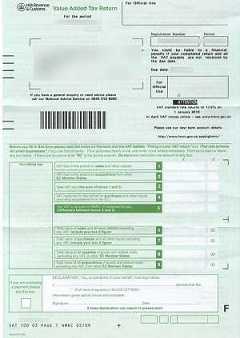VAT RETURNS : Business records for the accounting periods will include:
- Total sales and purchases made by the company.
- VAT amounts charged to customers and paid out on business purchases.
- How much is payable to HMRC (or the amount you can reclaim).
- The amount refundable to the business by HM Revenue and Customs.
Note: The company must file and submit a VAT Return even in cases where there is nothing to pay or reclaim.
Submitting Final VAT Return Deadline
Your business must submit a final VAT Return any time you cancel VAT registration. As a rule, you can complete this process online using a Government Gateway account.
What is the final VAT Return deadline if you deregister? HMRC give you two (2) months to submit the final return after deregistering. Account for all outstanding VAT on supplies made and received prior to deregistration on this return.
Different VAT Return rules apply when cancelling the registration through insolvency. You would need to complete the paper VAT return form to file a final Vat Return. You can contact HMRC to get the correct forms sent to you.
Filling In Your VAT Return
After filling in the form you can submit a VAT Return online or by postal methods. Extra guidance notes are also available using any of the following. Research more information on the Value Added Tax:
- Notice 700: The VAT Guide.
- Notice 733: Flat Rate VAT Scheme for small businesses.
- Notice 727: Retail Schemes.
- Notice 700/12: How to fill in a VAT Return and submit it.
Note: The HMRC VAT Return must include EU sales (where applicable). Completing an EC Sales List is part of business tax rules for small businesses in the United Kingdom.
Working Out the amount to Claim
Only VAT businesses can claim back the tax from HMRC. The company can reclaim the tax on business related purchases and expenses.
Sometimes a claim will also include personal use for the activity. In this case you need to work out the business element of the item or service.
In simple terms, you can only claim for the business element
An Example: You buy a computer system and use it 60% for business and 40% for your personal use. In this example the business can only reclaim 60% of the Value Added Tax paid out.

The business must keep all records to support any claims made. They must show the exact amount paid out for the expense or service. But, the company can use electronic or hard copy versions for keeping VAT records.
Note: Different rules apply when charging VAT to charities. As a rule they pay a reduced amount on certain goods and services.
A List of Exceptions
The business cannot reclaim VAT on entertainment expenses or if it uses the Flat Rate Scheme. Exceptions apply for purchases of a qualifying capital asset over the current limit.
Special HMRC VAT Return rules apply when calculating how to reclaim VAT amounts for:
- Buying a new vehicle such as on cars, a van, or a tractor (includes repairs and fuel costs).
- Staff travel expenses such as car rental or accommodation.
- Businesses partly exempt from paying Value Added Tax.
Using Estimated Figures
Businesses must ask for permission from HMRC to use estimated figures. But, you must give them a valid reason why accurate figures cannot get entered into a VAT Return.
An example could be if an accountant leaves a company without notice. In some cases that could make it difficult for filing before the VAT Returns deadline.
If HMRC grant permission they will not charge you a penalty. But, only if you meet payment deadlines and make no careless or deliberate errors. As a rule the correct figures must then get filed in the next company VAT Return.
Writing Off Bad Debts for VAT Returns
Sometimes a company decides to write off a bad debt. In this case the amount of VAT paid to HMRC can get reclaimed. As a rule, to qualify for this relief, the debt must:
- Over six months old and less than four years and six months old.
- Have not been ‘sold on‘.
- Be the original sales price (not more than the normal price for the item).
Add the details to ‘Box 4 on the VAT Return‘ to reclaim the amount. The business must keep all records of the debt.
Any debt that gets paid after you have already claimed relief must get returned to HMRC. Achieve this by adding the amount of the paid debt into ‘Box 1‘ of the next business VAT Return.
ALSO IN THIS SECTION
How to Send a VAT Return UK
VAT registered businesses must file a VAT return on a regular basis with HM Revenue and Customs. Check a page explaining the full process for submitting VAT returns online to HMRC.
Note: What happens if you get a VAT notice of assessment for tax? You must submit the Tax return and payment to HMRC without delay (e.g. log in to use VAT online services).
VAT Interest Rate
Businesses need to pay interest on underpaid or on overpaid VAT. Failing to report, or pay the correct amount of tax, means HM Revenue and Customs will charge VAT interest rates on the amounts.
VAT Return Deadlines
As a manager, you would be able to check some essential information inside your company VAT online account. The details include the VAT Return and VAT payment deadlines.
Note: You can use the VAT payment deadline calculator to work out the VAT payment deadline for an accounting period.

